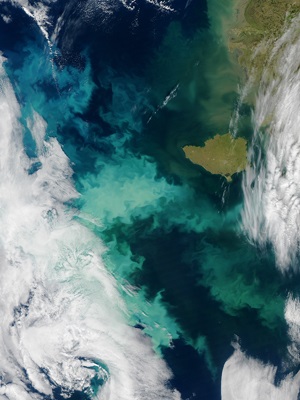This article is a reprint of a news release posted by the US National Oceanic and Atmospheric Administration (NOAA) on Dec 17, 2014.
A new NOAA-led report shows that Arctic air temperatures continue to rise at more than twice the rate of global air temperatures, a phenomenon known as Arctic amplification. Increasing air and sea surface temperatures, declining reflectivity at the surface of the Greenland ice sheet, shrinking spring snow cover on land and summer ice on the ocean, and declining populations and health of some polar bear populations are among the observations released today in the Arctic Report Card 2014.
Polar bears depend on sea ice for dens, food and mating. The loss of sea ice is affecting some polar bear populations and health. (Credit: Kathy Crane, NOAA)
“Arctic warming is setting off changes that affect people and the environment in this fragile region, and has broader effects beyond the Arctic on global security, trade, and climate,” Craig McLean, acting assistant administrator for the NOAA Office of Oceanic and Atmospheric Research, said during a press conference today at the annual American Geophysical Union Fall Meeting in San Francisco. “This year’s Arctic Report Card shows the importance of international collaboration on long-term observing programs that can provide vital information to inform decisions by citizens, policymakers and industry.”

As sea ice retreats in summer, more sunlight reaches the upper layers of the sea, triggering increased blooms of phytoplankton such as here in the Bering Sea this fall. (Credit: NASA)
McLean joined other scientists to release the Arctic Report Card, an annual update provided since 2006, that summarizes changing conditions in the Arctic. Some 63 authors from 13 countries, United States and other nation’s federal agencies and academia contributed to the peer-reviewed report. This year’s report features updates on key indicators as well as a new report on the status of polar bears. Major findings of this year’s report include:
“The Arctic Report Card 2014 presents observations vital for documenting the state of the Arctic environmental system, understanding the complex interactions and feedbacks within the system, and predicting its future,” said Martin Jeffries, Ph.D., principal editor of the 2014 Report Card, and Arctic Science Advisor and Program Officer for Arctic and Global Prediction, Office of Naval Research. “Observing, understanding and predicting are essential elements of the Arctic Research Plan of the Inter-agency Arctic Research Policy Committee and the implementation of the U.S. National Strategy for the Arctic Region.”
The extent of sea ice in September 2014 was the sixth lowest since satellite observations began in 1979. (Credit: NOAA)
A special essay in this year’s report card, written by the Norwegian Polar Institute and Polar Bears International, assesses polar bear populations in some areas where good long term data are available. The most recent data shows that a population decline in western Hudson Bay, Canada, was due to earlier sea ice break-up, later freeze-up and, thus, a shorter sea ice season. Polar bears depend on sea ice to travel, hunt, and mate, and in some areas, to den. Data shows that polar bear numbers had stabilized in the southern Beaufort Sea, after about a 40 percent decline since 2001. Polar bear condition and reproductive rates in the Chukchi Sea have been stable for 20 years, where sea ice is also declining though not as rapidly as in the southern Beaufort Sea.
In 2006, NOAA’s Climate Program Office introduced the State of the Arctic Report which established a baseline of conditions at the beginning of the 21st century. It is updated annually as the Arctic Report Card to document the often-quickly changing conditions in the Arctic. To view this year’s report, visit http://www.arctic.noaa.gov/reportcard/.
NOAA's mission is to understand and predict changes in the Earth's environment, from the depths of the ocean to the surface of the sun, and to conserve and manage our coastal and marine resources. Join us on Twitter, Facebook, Instagram and our other social media channels. Visit our news release archive.
Posted by John Hartz on Friday, 19 December, 2014
 |
The Skeptical Science website by Skeptical Science is licensed under a Creative Commons Attribution 3.0 Unported License. |